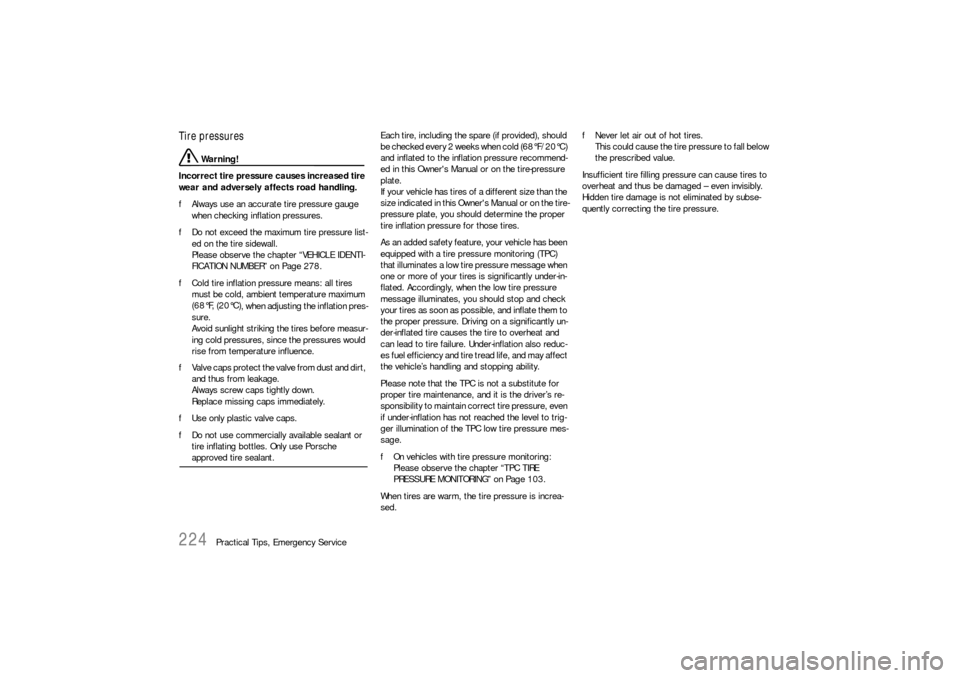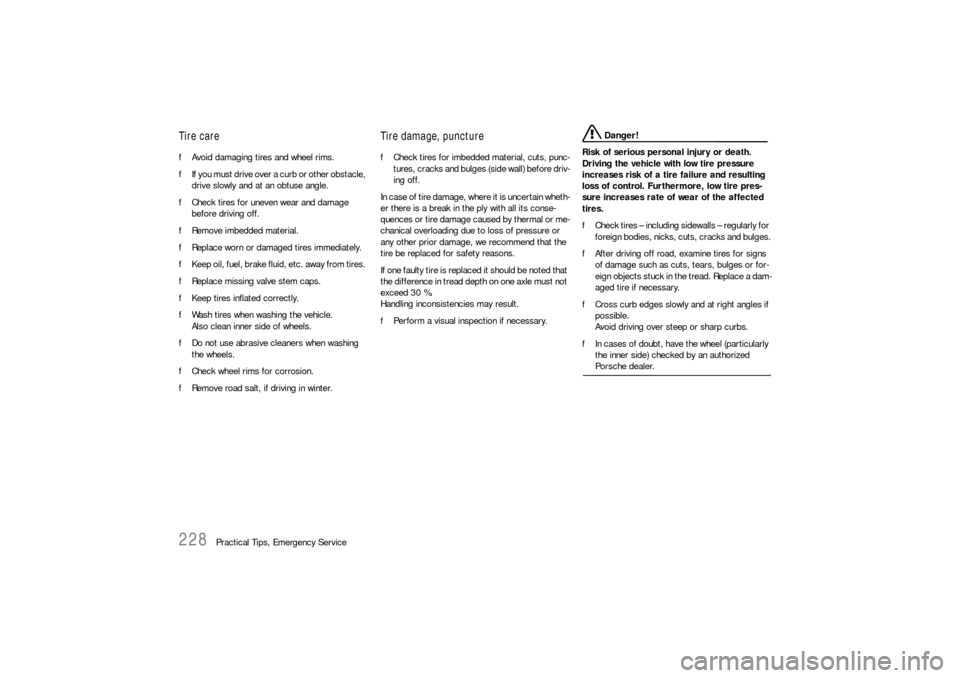2006 PORSCHE BOXSTER fuel pressure
[x] Cancel search: fuel pressurePage 218 of 296

218
Maintenance, Car Care
Storing your Porsche If you intend to store your Porsche for a prolonged
period, please consult your authorized Porsche
dealer. The staff will be glad to advise you on the
most suitable and necessary methods.
fClean your vehicle thoroughly inside and out-
side.
Clean the engine compartment.
The under carriage and chassis components
should be free of dirt and salt deposits.
fFill up the fuel tank.
fChange the oil and oil filter, and run the engine
for several minutes.
fIncrease the tire pressure to 58 psi (4 bar).
It is not recommended to lift the vehicle, due to
the possibility of corrosion on shock absorber
piston shafts.
The vehicle should be moved slightly, approxi-
mately every four weeks, to prevent flat spot
on the tires. Climate control
The air conditioning system should be in good wor-
king condition and fully charged.
Windshield/Headlight washer
fCheck and correct antifreeze/cleaning solution
level as necessary.
Electrical system
fRemove the battery from the vehicle and store
it in a cool dry place, not on a cement floor.
When the battery is disconnected, the
alarm system is deactivated.
fRecharge the battery every 3 months. If the
battery remains in the vehicle with the cables
connected, it is necessary to check, remove
and recharge the battery every 2-3 weeks.
Do not fast charge the battery.
fPlease observe the chapter “BULB CHART” on
Page 259. Vehicle interior
The interior must be dry, especially in the area of
the floor carpets. The use of drying agents (Silica-
Gel) is recommended in vehicles with leather inte-
rior and in areas with high humidity. The recom-
mended amount is 3 fabric bags of 1.1 lbs. (500
grams) each placed on the floor carpets.
Windows, doors, lids and top must be closed. The
air vents should be opened.
Page 224 of 296

224
Practical Tips, Emergency Service
Tire pressures
Warning!
Incorrect tire pressure causes increased tire
wear and adversely affects road handling.
fAlways use an accurate tire pressure gauge
when checking inflation pressures.
fDo not exceed the maximum tire pressure list-
ed on the tire sidewall.
Please observe the chapter “VEHICLE IDENTI-
FICATION NUMBER” on Page 278.
fCold tire inflation pressure means: all tires
must be cold, ambient temperature maximum
(68°F, (20°C)
, when adjusting the inflation pres-
sure.
Avoid sunlight striking the tires before measur-
ing cold pressures, since the pressures would
rise from temperature influence.
fValve caps protect the valve from dust and dirt,
and thus from leakage.
Always screw caps tightly down.
Replace missing caps immediately.
fUse only plastic valve caps.
fDo not use commercially available sealant or
tire inflating bottles. Only use Porsche approved tire sealant.Each tire, including the spare (if provided), should
be checked every 2 weeks when cold (68°F/20°C)
and inflated to the inflation pressure recommend-
ed in this Owner's Manual or on the tire-pressure
plate.
If your vehicle has tires of a different size than the
size indicated in this Owner's Manual or on the tire-
pressure plate, you should determine the proper
tire inflation pressure for those tires.
As an added safety feature, your vehicle has been
equipped with a tire pressure monitoring (TPC)
that illuminates a low tire pressure message when
one or more of your tires is significantly under-in-
flated. Accordingly, when the low tire pressure
message illuminates, you should stop and check
your tires as soon as possible, and inflate them to
the proper pressure. Driving on a significantly un-
der-inflated tire causes the tire to overheat and
can lead to tire failure. Under-inflation also reduc-
es fuel efficiency and tire tread life, and may affect
the vehicle’s handling and stopping ability.
Please note that the TPC is not a substitute for
proper tire maintenance, and it is the driver’s re-
sponsibility to maintain correct tire pressure, even
if under-inflation has not reached the level to trig-
ger illumination of the TPC low tire pressure mes-
sage.
fOn vehicles with tire pressure monitoring:
Please observe the chapter “TPC TIRE
PRESSURE MONITORING” on Page 103.
When tires are warm, the tire pressure is increa-
sed.fNever let air out of hot tires.
This could cause the tire pressure to fall below
the prescribed value.
Insufficient tire filling pressure can cause tires to
overheat and thus be damaged – even invisibly.
Hidden tire damage is not eliminated by subse-
quently correcting the tire pressure.
Page 228 of 296

228
Practical Tips, Emergency Service
Tire care fAvoid damaging tires and wheel rims.
fIf you must drive over a curb or other obstacle,
drive slowly and at an obtuse angle.
fCheck tires for uneven wear and damage
before driving off.
fRemove imbedded material.
fReplace worn or damaged tires immediately.
fKeep oil, fuel, brake fluid, etc. away from tires.
fReplace missing valve stem caps.
fKeep tires inflated correctly.
fWash tires when washing the vehicle.
Also clean inner side of wheels.
fDo not use abrasive cleaners when washing
the wheels.
fCheck wheel rims for corrosion.
fRemove road salt, if driving in winter.
Tire damage, puncture fCheck tires for imbedded material, cuts, punc-
tures, cracks and bulges (side wall) before driv-
ing off.
In case of tire damage, where it is uncertain wheth-
er there is a break in the ply with all its conse-
quences or tire damage caused by thermal or me-
chanical overloading due to loss of pressure or
any other prior damage, we recommend that the
tire be replaced for safety reasons.
I f o n e f a u l t y t i re i s re p l a c e d i t s h o u l d b e n o t e d t h a t
the difference in tread depth on one axle must not
exceed 30 %.
Handling inconsistencies may result.
fPerform a visual inspection if necessary.
Danger!
Risk of serious personal injury or death.
Driving the vehicle with low tire pressure
increases risk of a tire failure and resulting
loss of control. Furthermore, low tire pres-
sure increases rate of wear of the affected
tires.
fCheck tires – including sidewalls – regularly for
foreign bodies, nicks, cuts, cracks and bulges.
fAfter driving off road, examine tires for signs
of damage such as cuts, tears, bulges or for-
eign objects stuck in the tread. Replace a dam-
aged tire if necessary.
fCross curb edges slowly and at right angles if
possible.
Avoid driving over steep or sharp curbs.
fIn cases of doubt, have the wheel (particularly
the inner side) checked by an authorized Porsche dealer.
Page 272 of 296

272
Practical Tips, Emergency Service
Adjusting Headlights fPlease observe the chapter “REPLACING BUL-
BS” on Page 258.
Adjustment
The adjustment is made with the vehicle ready to
drive and the fuel tank completely filled.
The driver’s seat must be loaded by a person or a
165 lbs. (75 kg) weight and the tire pressures
must meet the prescribed values.
After being loaded, the car must be rolled a few
meters so that the suspension can settle.
For checking the headlight adjustment, the verti-
cal position of the cutoff of the lowbeam (see fig.)
has to be projected on a vertical screen (wall) in
distance of 24.6 ft. (7.5 m) from the front lens of
the headlamp.
The correct position of the cutoff is 2.0 in. (5 cm)
at 24.6 ft. or 7.5 m (0.4°) below a horizontal line,
x cm from ground to the center of the headlamp
lens. Lateral adjustment of the headlights should be
carried out at a specialist workshop with an optical
adjustment unit.
Distance
Visual aim shall be performed at not less than
24.6 ft. (7.5) m (this value is a rounded down con-
version from the 25-foot distance typical of field
aim using a screen). The 24.6 ft. (7.5 m) distance
is measured from the headlamp lens to the view-
ing screen.
Page 295 of 296

Index
295
RRadiator fans .............................................. 187
Radio reception .......................................... 155
Rain sensor ................................................ 126
Range on remaining fuel ........................93
, 114
Rear fog light .....................................124, 269
Rear lid ...................................................... 148
Rear spoiler............................................68, 69
Rear view mirrors ......................................... 31
Rear window defogger.................................. 33
Rear wing
Retractable........................................... 68
Relays ........................................................ 246
Release button ........................................... 163
Remote control ............................................. 18
Replacement key .......................................... 17
Replacing bulbs .......................................... 259
Replacing wiper blades................................ 185
Retractable spoiler........................................ 68
Rims
Diameter ............................................ 234
Rim width ........................................... 234
Running in .................................................... 14
SSafety belts ..........................................42
, 217
Warning light ........................................ 43
Safety compliance sticker ........................... 278
Sealing set ................................................. 239
Seals, care of ............................................. 215
Seat ............................................................ 34
Adjustment ........................................... 34
Heating ................................................ 38Memory................................................36
Selector lever .............................................163
Selector lever position indicator ............ 87
, 165
Shifting gear ...............................................162
Shiftlock .....................................................163
Side lights ..................................................269
Side marker light ............................... 124, 268
Side vents ..................................................136
Snow chains .............................. 232
, 283
, 284
Snow tires ......................................... 231, 282
Sockets .....................................................140
Spacers .....................................................244
Spare key .....................................................17
Spare wheel ...............................................284
Speed code letter .......................................233
Speed control .............................. 82
, 129
, 130
Speed limit .......................................... 94, 233
Speedometer................................................84
Spoiler .........................................................68
Fixed ....................................................69
Retractable ...........................................68
Sport mode ..................................... 63
, 66, 67
Sports seat ..................................................34
Stability management system (PSM) ...............64
Starting ................................................. 74, 75
Starting and stopping the engine ....................74
Steering wheel
Adjustment ...........................................39
Buttons ................................................40
Lock ................................. 74
, 75, 76, 77
Rocker switches..................................163
Toggle switches ..................................163
Stopwatch ....................................................98
Storage options ..........................................142
Storing your Porsche..................................218Sun visors ................................................... 41
TTachometer ................................................. 85
Tail light ..................................................... 269
Tank .................................................. 196
, 197
cap ................................................... 197
Ventilation system.............................. 202
Telephone .................................................. 157
Temperature setting........................... 130, 133
Temperature, outside indicator ...................... 89
Test stand, measurements ............................ 66
Theft protection ........................................... 16
Tiptronic .................................................... 163
Indicator .............................................. 87
Tire pressure monitoring ............................. 103
Tires ................................... 14
, 221
, 282
, 283
Checking pressure............................. 241
Inscription .......................................... 233
Loading information ............................ 235
Pressure................................ 5
, 224
, 283
Pressure plate.................................... 279
Sealant .............................................. 239
Sidewall ............................................. 233
Size .................................................. 233
Tires and tire care ...................................... 221
Tools ......................................................... 152
Towing .............................................. 274, 275
Track ........................................................ 282
Transmission ............................. 161
, 162
, 281
Fluid .......................................... 208, 286
Trunk entrapment ....................................... 148
Turn signals ......................................... 85, 125